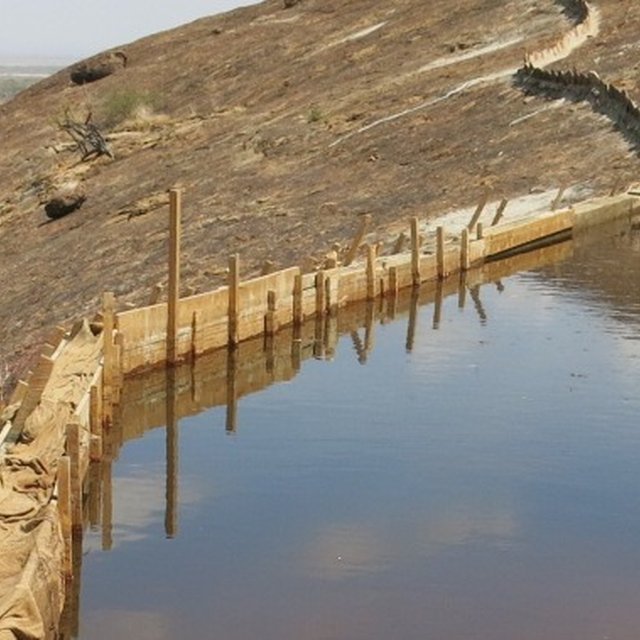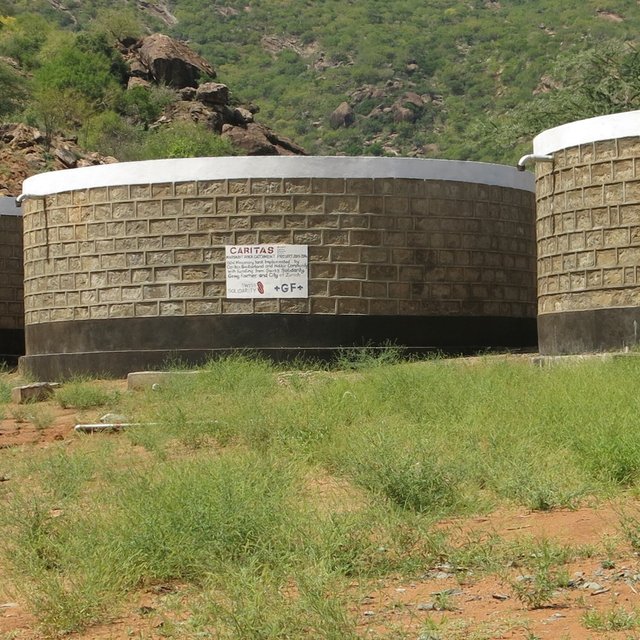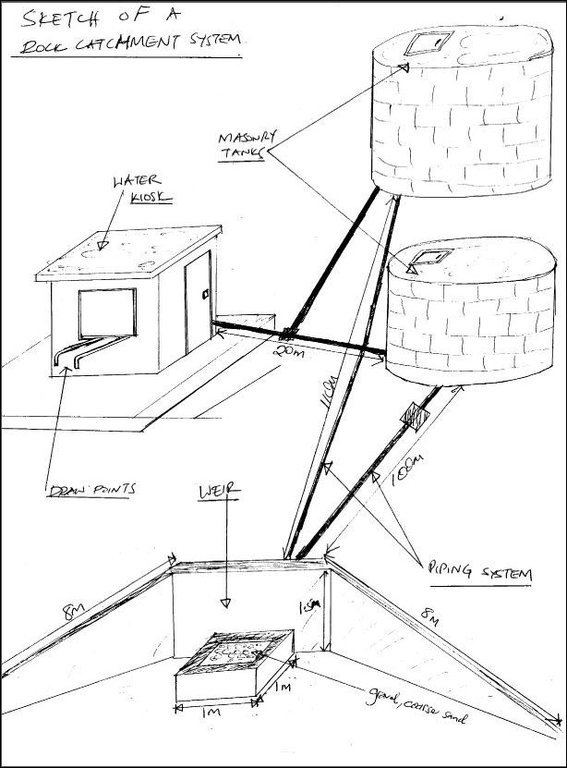



The Technology is built on a gently sloping outcrop on the hillside. The bare rockface is the surface from which rainwater is harvested. A weir is constructed at a strategic point for maximum collection towards the foot of the hill. The weir dams hold harvested water in the rock catchment and channels the water through a piping system to reservoirs, generally masonry tanks, located below the hill. A weir is usually a concrete wall constructed and reinforced with iron bars to give it adequate strength to withstand the weight of the dammed water. The length, height and thickness of a weir varies with the size and the slope of the rock catchment area. On average, a weir will be 10 meters long, 2 meters high and 0.5 meters thick. At the base of the weir, an infiltration box of approximately 1 square meter is constructed and filled from the bottom with fine sand, coarse sand and gravel (in that order) for the purpose of sieving out impurities before the water reaches the tanks. Metal piping is recommended for connecting the weir to the storage tanks downhill due to the high pressure exerted by owing water. The piping distance ranges from 15 to 300 meters from the weir to the storage tanks. Provision is usually made for additional pipelines in case there is need for expansion of the system. At the bottom of the hill, masonry tanks are constructed, ranging from 100 cubic meters capacity, or greater, depending on the impounded area,
population, and available resources. The pipes join the tanks through a control chamber meant for regulating water flow into the tanks. Adjacent to the tanks are water 'kiosks' where the community draws water. To gauge how much water is issued, a meter is fitted inside the kiosk. Metering the water is a measure for accountability and control. Construction of a rock catchment system needs heavy investment in materials - cement, quarry stones, ballast, iron bars, sand, hard-core stones, water, metallic (galvanised iron) pipes and plumbing
installations. Construction of the system is labour intensive in terms of both skilled and non-skilled personnel. The main purpose of the rock catchment
system is to harvest, and store rainwater for domestic - and some livestock - use. In the case of the documented project, the benefiting communities are pastoralists who live in northern Kenya, a region characterised by chronic droughts, seasonal floods and acute water shortages. The water situation is aggravated by increasing drought frequency and severity. On the other hand, the little rain received has often been destructive downstream, cutting through roads and causing massive soil erosion due to high water velocity. During the dry periods when open water sources such as earth pans dry up, women travel long distances to search for water from hand dug shallow wells within dry seasonal riverbeds ('sand rivers').

ទីតាំង: Implemented with three different communities in three locations, Ndikir, Manyatta Lengima and Mpagas., Laisamis sub county, Marsabit County, Kenya, ប្រទេសកេនយ៉ា
ចំនួនទីកន្លែងបច្ចេកទេស ដែលវិភាគ: 2-10 កន្លែង
ការសាយភាយនៃបច្ចេកទេស: អនុវត្តនៅកន្លែងជាក់លាក់មួយ/ ប្រមូលផ្តុំនៅតំបន់តូចៗ
តើស្ថិតក្នុងតំបន់ការពារអចិន្ត្រៃយ៍?:
កាលបរិច្ឆេទនៃការអនុវត្ត: 2015
ប្រភេទនៃការណែនាំឱ្យអនុវត្តន៍៖






| បញ្ជាក់ពីធាតុចូល | ឯកតា | បរិមាណ | ថ្លៃដើមក្នុងមួយឯកតា (ដុល្លារ) | ថ្លៃធាតុចូលសរុប (ដុល្លារ) | % នៃថ្លៃដើមដែលចំណាយដោយអ្នកប្រើប្រាស់ដី |
| កម្លាំងពលកម្ម | |||||
| Skilled labour | Days | 607,7 | 15,0 | 9115,5 | |
| Unskilled labour | Days | 1973,0 | 3,0 | 5919,0 | 40,0 |
| សម្ភារៈសាងសង់ | |||||
| Construction materials for all the four components together | 1 catchment system | 1,0 | 75407,0 | 75407,0 | |
| ថ្លៃដើមសរុបក្នុងការបង្កើតបច្ចេកទេស | 90'441.5 | ||||
| ថ្លៃដើមសរុបក្នុងការបង្កើតបច្ចេកទេសគិតជាដុល្លារ | 90'441.5 | ||||
| បញ្ជាក់ពីធាតុចូល | ឯកតា | បរិមាណ | ថ្លៃដើមក្នុងមួយឯកតា (ដុល្លារ) | ថ្លៃធាតុចូលសរុប (ដុល្លារ) | % នៃថ្លៃដើមដែលចំណាយដោយអ្នកប្រើប្រាស់ដី |
| ផ្សេងៗ | |||||
| Seasonal scooping of sand and silt from the weir | seasons/year | 2,0 | 100,0 | 200,0 | 100,0 |
| Broken parts and repairs | lumpsum | 1,0 | 300,0 | 300,0 | |
| ថ្លៃដើមសរុបសម្រាប់ការថែទាំដំណាំតាមបច្ចេកទេស | 500.0 | ||||
| ថ្លៃដើមសរុបសម្រាប់ការថែទាំដំណាំតាមបច្ចេកទេសគិតជាដុល្លារ | 500.0 | ||||
គុណភាពមុន SLM: 600 cubic meters
គុណភាពក្រោយ SLM: 3800 cubic meters
The community almost every year would need emergency water trucking. This is not so anymore.
គុណភាពមុន SLM: Borehole water was the only alternative source during dry season
គុណភាពក្រោយ SLM: Water free of salt is now available and adequate for domestic use
They no longer use the the highly saline water which has been reported to have adverse negative health effects. The harvested water is easy to treat for microbial contamination at the household level.
គុណភាពមុន SLM: N/A
គុណភាពក្រោយ SLM: N/A
The harvested water from the rock catchment is mostly for household use.
គុណភាពមុន SLM: N/A
គុណភាពក្រោយ SLM: N/A
The harvested water from the rock catchment is mostly for household use.
The time women used to spend in search of water has drastically reduced. They are now freer to engage and participating in social local networks and small businesses.
Women have benefited hugely from this Technology. Before the intervention, they would walk up to 5 kilometres in search of water for domestic use. This was particularly worse during drought or an extended dry spell as they also had to queue for many hours a day to get the water from available water points.
គុណភាពមុន SLM: N/A
គុណភាពក្រោយ SLM: N/A
The pastoralist communities have in the recent decades experienced resources-based conflicts. These conflicts happen at regional, communal and family scales. The communities and families benefiting from this intervention no longer have to fight over the resource because it is adequate.
គុណភាពមុន SLM: Little water available for hygiene practices such as handwashing
គុណភាពក្រោយ SLM: Additional of 30 litres per day now available for good hygiene practices
The availability of water have drastically improved hygiene practices.
គុណភាពមុន SLM: No properly functioning water managment committee
គុណភាពក្រោយ SLM: There is a vibrant and dedicated water management committee
The implementation of the Technology has invigorated the community members and they have shown better organisation to prudently manage the water system. The management committee was existing before the technology was implemented when they managed other water sources. However, the motivation then was low coupled with low capacity to operate and maintain the water sources they had.
គុណភាពមុន SLM: Several occurences of conflict over water
គុណភាពក្រោយ SLM: No more reason for conflict
The pastoral communities have in the recent decades experienced resources-based conflicts. These conflicts happen at regional, communal and family scales. The communities and families benefiting from this intervention no longer have to fight over the resource because it is adequate.
គុណភាពមុន SLM: About 6 hours spent a day in search of water especially during the dry season
គុណភាពក្រោយ SLM: A maximum of 30 minutes spent by a woman to fetch water
The Technology benefits women most who traditionally are socially and economically disadvantaged. Now they have more time to engage in other profitable activities. The Technology has also taken away the burden of proving water for the households, freeing them for greater social engagement
Water that would normally be lost almost after it has rained is now stored and kept for future use.
គុណភាពមុន SLM: All rainwater from the developed catchment was lost each time it rained.
គុណភាពក្រោយ SLM: About 3500 cubic meters of water is retained within the locality of the community
There is increased control of surface runoff reducing its damaging effects on soil, vegetation and infrstrature. However, the the scale to which this is realised is low.
គុណភាពមុន SLM: N/A
គុណភាពក្រោយ SLM: N/A
The rock catchment do not in any way lead to increased groundwater recharge.
គុណភាពមុន SLM: N/A
គុណភាពក្រោយ SLM: N/A
Due to reduced amount of water flowing from the hillside downstream, the ability of water to erode soil downstream is reduced though at very low scale.
គុណភាពមុន SLM: Water emergency supply at least two a year during the two dry spells.
គុណភាពក្រោយ SLM: No single water trucking done in the last two years
Water has been the most affected livelihood commodity during drought events among the benefiting community. The impact had been acute water shortage leading to external emergency interventions. It was also happened that sometimes when food aid was provided, the community would have no water to cook. There is no longer need for water emergency in these communities.
The high velocity water from the hills have been a constant menace in cutting or blocking roads downstream with debris. The harvesting of water has reduced the impact of this water at some sections of the hilly landscape.